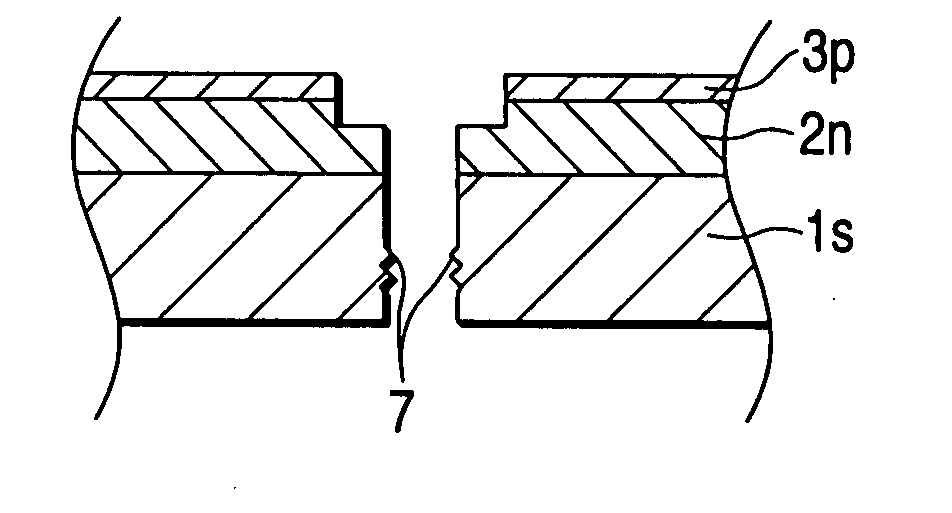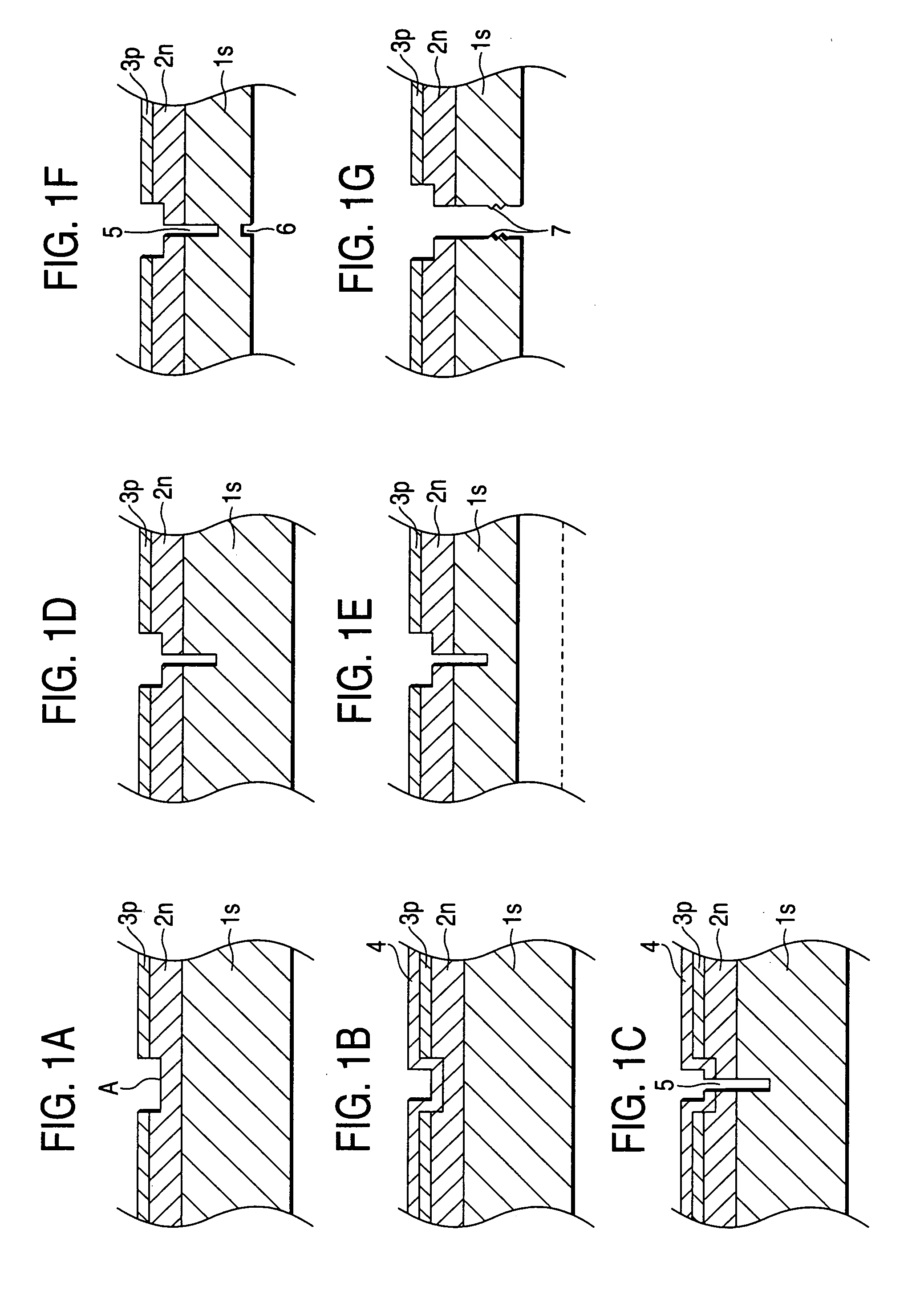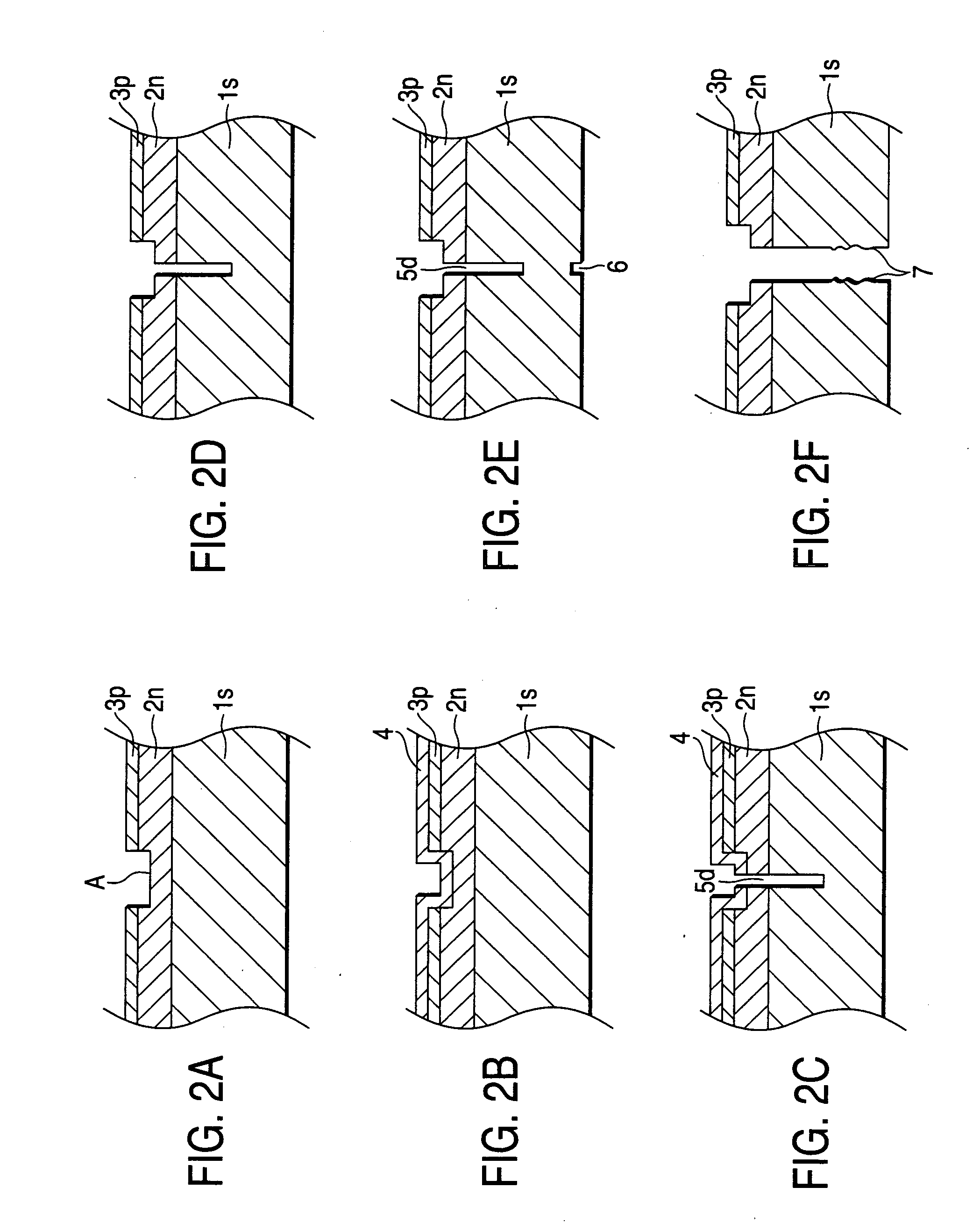Semiconductor element and method for producing the same
a semiconductor and element technology, applied in the direction of semiconductor lasers, semiconductor laser structural details, manufacturing tools, etc., can solve the problems of troublesome work, difficult processing, and difficulty in division compared with semiconductor elements made of other materials, and achieve the effect of improving reflecting efficiency and solving efficiently
- Summary
- Abstract
- Description
- Claims
- Application Information
AI Technical Summary
Benefits of technology
Problems solved by technology
Method used
Image
Examples
first embodiment
[0108]FIGS. 1A to 1G are step views (sectional views) for explaining a first embodiment of the invention. A plurality of Group III nitride compound semiconductor layers are formed on a substrate 1s for performing the formation of elements and the formation of electrodes. Although two Group III nitride compound semiconductor layers 2n and 3p are shown representatively in each of FIGS. 1A to 1G, the two layers 2n and 3p mean layers which must not be short-circuited and do not mean the fact that only two Group III nitride compound semiconductor layers are provided. Then, a state in which only the electrode-forming layer on a side near the substrate is left is formed on each parting line by etching or dicing due to a dicer (FIG. 1A). That is, concave portions A are formed. Here, the term “parting lines” means latticed frame-shaped lines in the case where ideal parting surfaces (perpendicular to the substrate is surface) for dividing the substrate 1s into individual Group III nitride com...
second embodiment
[0111]FIGS. 2A to 2F are step views (sectional views) for explaining a second embodiment of the invention. A state in which only the electrode-forming layer on a side near the substrate is left is formed on the parting lines by etching or dicing due to a dicer in the same manner as in the first embodiment shown in FIGS. 1A to 1G (FIG. 2A) In this case, it is a matter of course that etching or dicing due to a dicer may be performed until the substrate 1s is exposed or part of the front surface of the substrate 1s is removed. Then, a protective film 4 which can be removed by an after-process is formed on the whole front surface (FIG. 2B). Then, in this embodiment, first grooves 5d with a depth of not smaller than about ⅕ as large as the thickness of the substrate is are formed like a latticed frame in the front surface side (element-forming side) of the substrate 1s along the latticed frame-shaped parting lines (FIG. 2C). Then, the protective film 4 is removed together with reaction p...
third embodiment
[0113]FIGS. 3A to 3F are step views (sectional views) for explaining a third embodiment of the invention. A state in which only the electrode-forming layer on a side near the substrate is left is formed on the parting lines by etching or dicing due to a dicer in the same manner as in the second embodiment shown in FIGS. 2A to 2F (FIG. 3A). In this case, it is a matter of course that etching or dicing due to a dicer may be performed until the substrate 1s is exposed or part of the front surface of the substrate 1s is removed. Then, a protective film 4 which can be removed by an after-process is formed on the whole front surface (FIG. 3B). Then, first grooves 5d with a depth not smaller than the thickness of the thin-walled substrate 1s which will be polished by an after-process are formed like a latticed frame in the front surface side (element-forming side) of the substrate 1s along the latticed frame-shaped parting lines (FIG. 3C). Then, the protective film 4 is removed together wi...
PUM
| Property | Measurement | Unit |
|---|---|---|
| depth | aaaaa | aaaaa |
| thickness | aaaaa | aaaaa |
| thickness | aaaaa | aaaaa |
Abstract
Description
Claims
Application Information
 Login to View More
Login to View More - R&D
- Intellectual Property
- Life Sciences
- Materials
- Tech Scout
- Unparalleled Data Quality
- Higher Quality Content
- 60% Fewer Hallucinations
Browse by: Latest US Patents, China's latest patents, Technical Efficacy Thesaurus, Application Domain, Technology Topic, Popular Technical Reports.
© 2025 PatSnap. All rights reserved.Legal|Privacy policy|Modern Slavery Act Transparency Statement|Sitemap|About US| Contact US: help@patsnap.com



